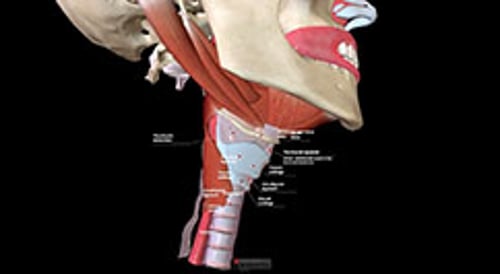Laryngoceles are evaginations of the mucous membrane of the laryngeal ventricle.
A laryngocele is an abnormal dilatation of the laryngeal saccule, often causing an air-filled sac to form within the larynx. There are 2 types of laryngoceles: internal and external. Internal laryngoceles displace and enlarge the false vocal folds and may result in hoarseness and airway obstruction. External laryngoceles extend through the thyrohyoid membrane, causing a mass in the neck. Laryngoceles often occur in musicians who play wind instruments.
Symptoms include dysphonia, cough, and a globus sensation. When laryngoceles are filled with air, they can be expanded by the Valsalva maneuver. They may become infected (laryngopyocele) when filled with mucoid fluid.
Diagnosis is based on laryngoscopic examination that demonstrates the air-filled sac, most commonly as dilatation at the level of the false vocal fold or with radiologic imaging such as a CT or MRI scan. Laryngoceles appear on CT as smooth, ovoid, low-density masses.
Treatment of laryngoceles is excision via either laryngoscopy (for internal laryngoceles) or external, transcervical approaches (1).
Reference
1. Singh R, Karantanis W, Fadhil M, Kumar SA, Crawford J, Jacobson I. Systematic review of laryngocele and pyolaryngocele management in the age of robotic surgery. J Int Med Res. 2020;48(10):300060520940441. doi:10.1177/0300060520940441



